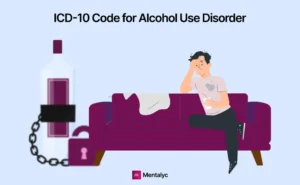Borderline Personality Disorder (BPD) is an often misunderstood and complex mental health condition that involves instability in how individuals relate to others, perceive themselves, and regulate their emotions. The Diagnostic and Statistical Manual of Mental Disorders, Fifth Edition, Text Revision (DSM-5-TR) outlines the DSM-5 criteria for Borderline Personality Disorder, which clinicians rely on to identify and evaluate symptoms accurately.
Understanding the Borderline Personality Disorder (BPD) DSM-5 criteria is essential for consistent assessment and diagnosis across diverse clinical settings. Tools like **Mentalyc** can enhance this process by helping clinicians document symptoms effectively, track emotional and behavioral patterns, and ensure that their progress notes align with the Borderline Personality Disorder DSM-5 framework — supporting clearer, more structured diagnostic decisions.
Key Symptoms of Borderline Personality Disorder
Borderline Personality Disorder (BPD) involves a range of symptoms that impact various aspects of an individual’s life, including their emotions, relationships, self-image, and behavior. Not all individuals with BPD experience every symptom, and the severity of each symptom can vary. Below is a detailed list of common Borderline Personality Disorder symptoms:
Fear of Abandonment. Individuals may experience fear of being abandoned or rejected by loved ones, which can lead to desperate attempts to avoid real or perceived abandonment – even if it means engaging in impulsive or harmful behaviors.
Unstable Relationships. Unstable and chaotic relationships involve intense emotional highs and lows. Maintaining long-term relationships is challenging due to difficulties in emotion regulation and management and the likelihood of frequent conflicts.
Identity Instability. Lack of a consistent and stable sense of self is common, and this may manifest as adopting different identities or personas in different situations or relationships.
Impulsive spending, substance abuse, reckless driving, unsafe sexual practices, and self-harm are common.
Suicidal Thoughts and Behaviors. There is often a heightened risk of suicidal ideation, suicide attempts, or recurrent thoughts of death and dying.
Intense and Rapidly Changing Emotions. Emotional instability and volatility are core features. Extreme mood swings shift rapidly from anger to sadness to euphoria, often in response to minor upsets.
Chronic Feelings of Emptiness. Inner emptiness and loneliness can contribute to impulsive behaviors and seeking attention and stimulation.
Inappropriate Bursts of Anger. Individuals struggle to control their anger, leading to frequent and intense outbursts. Minor events can trigger rage, which strains relationships.
Paranoid Thoughts. When stressed, people with BPD may experience paranoia. They may question others’ motives or perceive threats where none exist.
Feeling disconnected from themselves or their surroundings can lead to a sense of unreality or detachment.
Self-Destructive Behaviors. Self-mutilation, cutting, burning, or other forms of self-harm are used to cope with emotional pain or to feel more in control.
Idealization and Devaluation. Others are idealized initially and later devalued when they fail to meet expectations. This leads to a cycle of unstable relationships.
Impaired Impulse Control. Difficulties in managing impulses related to emotions, such as acting out in anger or making impulsive decisions.
Intense Loneliness. Individuals feel profoundly alone and disconnected from others, which contributes to emotional distress.
Difficulty with Intimacy. Due to fears of abandonment and emotional vulnerability, people with BPD struggle with forming and maintaining intimate relationships.
A formal Borderline Personality Disorder diagnosis requires a comprehensive assessment by a qualified mental health professional, who will consider the presence and severity of symptoms, as well as their impact on a client’s functioning and well-being, before making a diagnosis and recommending Borderline Personality Disorder treatment.
DSM-5-TR Diagnostic Criteria for Borderline Personality Disorder, 301.83 (F60.3)
| Criterion No. | DSM-5-TR Diagnostic Feature | Description |
|---|---|---|
| 1 | Frantic efforts to avoid real or imagined abandonment | Individuals go to extreme lengths to prevent perceived or actual rejection or separation. |
| 2 | Pattern of unstable and intense interpersonal relationships | Relationships alternate between extremes of idealization and devaluation, reflecting emotional instability. |
| 3 | Identity disturbance | Identity disturbance and self-concept issues cause unstable self-image, shifting goals, and unclear sense of self. |
| 4 | Impulsivity in at least two areas that are potentially self-damaging | Includes reckless spending, unsafe sex, substance abuse, binge eating, or reckless driving. |
| 5 | Recurrent suicidal behavior or self-mutilation | Includes suicidal threats, gestures, or self-harming actions in response to emotional distress. |
| 6 | Affective instability due to marked reactivity of mood | Emotional instability and impulsivity cause mood swings lasting from a few hours to days. |
| 7 | Chronic feelings of emptiness | Persistent inner void, dissatisfaction, and lack of fulfillment that drive impulsive behaviors. |
| 8 | Inappropriate, intense anger or difficulty controlling anger | Inappropriate, intense anger episodes lead to temper outbursts, resentment, or physical altercations. |
| 9 | Transient, stress-related paranoid ideation or severe dissociative symptoms | Short-lived stress-related paranoia or dissociation triggered by emotional stress. |
A pattern of instability in interpersonal relationships, self-image, affect, and marked impulsivity, beginning by early adulthood and present in a variety of contexts, as indicated by five (or more) of the following BPD diagnostic criteria:
1. Frantic efforts to avoid real or imagined abandonment. One hallmark feature is the intense fear of abandonment. Individuals with BPD often experience a sense of emptiness, loneliness, and instability in relationships, which leads them to go to great lengths to avoid being left alone. This can manifest as frantic efforts to maintain relationships, whether by engaging in extreme behaviors or tolerating mistreatment. These are among the most recognizable BPD traits and features, often reflecting the deep-seated fear of loss and rejection.
2. A pattern of unstable and intense interpersonal relationships characterized by alternating between extremes of idealization and devaluation. People with BPD struggle with maintaining stable and healthy relationships because of intense mood swings and impulsivity. Relationships swing between idealization and devaluation, where they adore someone one moment and vilify them the next. Erratic shifts lead to frequent conflict, making it challenging to establish and maintain long-term relationships.
3. Identity disturbance: markedly and persistently unstable self-image or sense of self. Individuals grapple with an unstable self-image and a fragmented sense of identity. This instability may manifest as frequent shifts in values, goals, career aspirations, and even sexual orientation. People with BPD struggle to understand who they are and what they want in life, contributing to emotional turmoil.
4. Impulsivity in at least two areas that are potentially self-damaging:
- reckless driving
- overspending
- substance abuse
- sexual behaviors
- binge eating
Impulsive behaviors are often driven by the need to reduce emotional distress or to seek stimulation.
1. Suicidal behavior, gestures, threats, or self-mutilating behaviors. BPD is strongly associated with a heightened risk of self-harm and suicidal behaviors.
2. Affective instability due to marked reactivity of mood (e.g., intense episodic dysphoria, irritability, or anxiety usually lasting a few hours and only rarely more than a few days). Intense and rapidly changing emotional states may fluctuate from profound sadness or anger to euphoria within a brief timeframe. Emotional swings can be triggered by minor events.
3. Chronic feelings of emptiness. A pervasive sense of emptiness is a common experience for individuals with BPD. This feeling of inner void and dissatisfaction can contribute to impulsive behaviors, substance abuse, and difficulty forming meaningful connections.
4. Inappropriate, intense anger or difficulty controlling anger (e.g., frequent displays of temper, constant anger, or recurrent physical altercations). Anger can be intense and difficult to manage. Minor provocations can trigger outbursts that lead to confrontations. Emotional dysregulation contributes to the challenges in maintaining stable relationships.
5. Transient, stress-related paranoid ideation, or severe dissociative symptoms. Individuals with BPD may experience paranoia or dissociation, particularly in response to stress.
Borderline Personality Disorder Differential Diagnosis: Distinguishing BPD from Other Disorders
The diagnosis of BPD requires careful consideration of a range of factors to differentiate it from other mental health conditions with similar symptoms. Here are some of the conditions to consider when diagnosing BPD:
Bipolar Disorder (Type II) – can be mistaken for BPD due to mood swings. In bipolar disorder, mood swings are typically more prolonged and less reactive to external events. Bipolar disorder is characterized by periods of elevated mood (mania) and low mood (depression).
Depressive Disorders – share symptoms of emotional instability and mood swings with BPD. The core features of BPD (intense fear of abandonment and identity disturbance) are generally not found in purely mood-related disorders.
Post-Traumatic Stress Disorder (PTSD) – trauma-related disorders can include dissociation, mood swings, and impulsivity, which overlaps with BPD.
Attention-Deficit/Hyperactivity Disorder (ADHD) – ADHD can involve impulsivity, inattention, and mood swings. While there is some symptom overlap, ADHD typically starts in childhood and involves difficulties in focus and impulse control that are not tied to emotional dysregulation disorder patterns often seen in BPD.
Substance Use Disorders – can lead to impulsive behaviors, emotional instability, and relationship issues. Assess whether these symptoms are driven by substance use or whether they persist even in the absence of intoxication or withdrawal.
Antisocial Personality Disorder (ASPD) – shares impulsivity and difficulty with relationships with BPD, but ASPD involves a disregard for the rights of others and/or criminal behavior.
Histrionic Personality Disorder – involves intense and unstable relationships, but the focus is seeking attention and being the center of attention.
Narcissistic Personality Disorder (NPD) – involves unstable self-esteem and difficulties with relationships. NPD is characterized by a grandiose sense of self-importance and a lack of empathy.
Schizotypal Personality Disorder – involves odd beliefs, social isolation, and eccentric behavior, which may overlap with BPD symptoms. The core features of BPD are not as central in schizotypal personality disorder, though it still falls under the broader classification of DSM-5 personality disorders that clinicians must consider during assessment.
Anxiety Disorders – generalized anxiety disorder or social anxiety disorder can involve emotional sensitivity and interpersonal difficulties. However, the intense fear of abandonment and identity disturbance differentiate BPD from anxiety disorders.
Diagnosing BPD requires a comprehensive assessment by a trained mental health professional. The presence, duration, and impact of specific symptoms, as well as history and context, are all critical factors to explore when making an accurate diagnosis and formulating an appropriate treatment plan.
Clinical Implications for Diagnosis and Therapy
Accurate diagnosis paves the way for appropriate treatment strategies. While BPD can be challenging to treat, various therapeutic approaches, such as Dialectical Behavior Therapy for BPD (DBT), Cognitive-Behavioral Therapy (CBT), and Psychodynamic Therapy, have shown promise in helping clients manage symptoms, regulate emotions, and improve interpersonal functioning.
Mental health professionals can use a variety of tests and assessment tools, including:
- the McLean screening instrument for BPD (Borderline Personality Disorder).
- a structured clinical interview for DSM-5-TR personality disorders.
- the Minnesota Borderline Personality Disorder Scale.
- the Personality Assessment Inventory Borderline Scale.
Prevalence and Risk Factors
BPD is estimated to affect 1.6% of the general population (Chapman, Jamil, & Fleisher, 2022). BPD is diagnosed more frequently in clinical settings, such as mental health treatment centers and hospitals, where the prevalence may be higher (ranging from 10-20% among psychiatric patients). BPD is more commonly diagnosed in females, and it typically emerges in late adolescence or early adulthood.
Risk Factors and Causes of Borderline Personality Disorder
BPD is influenced by genetic, environmental, and psychological factors. BPD risk factors and causes include:
- Genetics: BPD has a heritable component, as individuals with a family history of BPD or other mental health conditions may be at a higher risk of developing BPD (Witt, Streit, & Jungkunz, 2017).
- Early Trauma or Abuse: Childhood trauma, neglect, physical or sexual abuse, and other adverse experiences during childhood can significantly increase the risk of developing BPD.
- Invalidating Environments: Growing up in environments where emotions and experiences are invalidated or dismissed can contribute to the development of BPD. Children who are consistently told their feelings are wrong or unimportant may struggle to regulate their emotions and form a stable sense of identity.
- Neurobiological Factors: There are differences in brain structure and function among individuals with BPD, particularly in areas associated with emotional regulation and impulse control.
- Impulsivity and Sensation-Seeking: Individuals who are naturally impulsive or prone to seeking out intense experiences are at an increased risk of developing BPD.
- Personality Traits: Certain personality traits can predispose individuals to BPD, as these traits may interact with environmental factors to increase risk.
- Family Dynamics: Dysfunctional family dynamics can contribute to the development of BPD.
- Other Mental Health Conditions: BPD often co-occurs with other mental health disorders, such as depression, anxiety, and substance abuse.
The interplay between genetics, environment, and experiences is complex and varies from person to person. Early intervention, supportive environments, and appropriate treatment play a crucial role in reducing the impact of risk factors and improving outcomes for individuals at risk of or diagnosed with BPD.
Final Thoughts: Understanding and Supporting Individuals with BPD
The DSM-5 TR criteria for diagnosing BPD provides a comprehensive framework to understand the complex and chaotic experiences of individuals. By identifying the interplay of abandonment fears, identity disturbances, emotional dysregulation, and impulsive behaviors, mental health professionals can offer tailored interventions that provide relief and support to clients with BPD. Increased awareness and education can help reduce stigma and promote empathy, fostering a more compassionate and informed society for clients struggling with this challenging personality disorder.
Simplify Clinical Documentation and Diagnosis with Mentalyc
Mentalyc is an AI-powered documentation assistant built specifically for mental health professionals. It helps therapists create accurate, compliant, and time-saving notes — from progress notes and treatment plans to diagnostic documentation — in just minutes.
Beyond note-taking, Mentalyc actively supports diagnostic accuracy. Its structured templates align with DSM-5 criteria, helping clinicians organize observations, symptoms, and behavioral data in a way that strengthens diagnostic clarity. The platform automatically references session insights and continuity of care, ensuring that every record supports the “golden thread” of diagnosis, treatment, and progress.
Designed with privacy and ethics in mind, Mentalyc ensures all data is encrypted and HIPAA-compliant, so clinicians can document confidently without compromising security.
Start simplifying your documentation and improving diagnostic precision — register for free on Mentalyc and experience how AI can elevate your clinical workflow.
Mentalyc Plans & Pricing
| Plan | Price | Key Features |
| 14-Day Free Trial | $0 | 14 days of full PRO access, including 15 notes—no credit card required. |
| Mini | USD 14.99 /month | Record in-person sessions, upload audio files, use voice-to-text, or type notes directly, etc |
| Basic | USD 29.99 /month | Everything in Mini, plus: Alliance Genie™ NEW! (limited access), Smart TP™ |
| Pro | USD 59.99 /month | EMDR, Play and Psychiatry modalities,100+ custom templates incld. BIRP, PIRP, GIRP, PIE, and SIRP, Auto-computed CPT codes |
| Super | USD 99.99 /month | Everything in Pro,plus: Group therapynotes for each groupmember, Priorityonboarding andsupport |
For more information, visit the pricing page on our website.
Frequently Asked Questions (FAQs) About Borderline Personality Disorder DSM-5 Criteria
What Is Borderline Personality Disorder (BPD)?
Borderline Personality Disorder (BPD) is a complex mental health condition characterized by emotional instability and impulsivity, difficulties in relationships, and disturbances in self-identity. Individuals often experience intense emotions, fear of abandonment and rejection, and fluctuating moods that make daily life and interpersonal connections challenging. According to the BPD DSM-5-TR, the disorder involves a pervasive pattern of instability in affect, self-image, and behavior, typically beginning in early adulthood and present across various contexts.
What are the DSM-5 criteria for BPD?
The DSM-5-TR outlines nine diagnostic criteria for BPD, and a diagnosis is made when at least five are present. These include:
- Frantic efforts to avoid abandonment.
- A pattern of unstable self-image and relationships marked by alternating extremes of idealization and devaluation.
- Identity disturbance and self-concept issues, leading to confusion about goals, values, or roles.
- Impulsivity in self-damaging areas (e.g., spending, sex, substance use).
- Recurrent suicidal behaviors or self-harm.
- Affective instability due to marked mood reactivity.
- Chronic feelings of emptiness.
- Inappropriate, intense anger episodes or difficulty controlling anger.
- Stress-related paranoia or dissociation under pressure.
What are 9 traits of BPD?
The nine core BPD traits reflect how the disorder impacts emotions, behavior, and relationships. These include instability in mood, self-image, and relationships; impulsive behaviors; intense anger; chronic feelings of emptiness; a deep fear of abandonment and rejection; self-harming tendencies; and emotional instability and impulsivity. Each individual may experience these traits differently, and their intensity can fluctuate based on life stressors and interpersonal dynamics.
What are 5 symptoms of BPD?
While the full diagnostic criteria include nine features, five common symptoms seen in clinical practice include:
- Emotional instability and impulsivity.
- Unstable self-image and relationships.
- Fear of abandonment and rejection.
- Chronic feelings of emptiness.
- Inappropriate, intense anger episodes or difficulty managing anger.
These symptoms often overlap with other conditions, highlighting the importance of an accurate diagnosis.
What are the Diagnostic Tools and Clinical Assessment Methods for BPD?
A comprehensive clinical assessment for BPD involves structured interviews, standardized questionnaires, and observation of interpersonal patterns. Common tools include:
- The McLean Screening Instrument for BPD (MSI-BPD).
- The Personality Assessment Inventory – Borderline Features Scale (PAI-BOR).
- The Structured Clinical Interview for DSM-5 Personality Disorders (SCID-5-PD).
Clinicians also evaluate differential diagnosis in personality disorders, distinguishing BPD from conditions such as BPD vs bipolar disorder, PTSD, or major depression, as these can share overlapping symptoms like mood instability or impulsivity.
What are the Treatment and Management Approaches for BPD?
Effective management of BPD involves therapeutic interventions for emotional regulation and improving interpersonal functioning. The gold standard treatment is Dialectical Behavior Therapy (DBT), which teaches mindfulness, distress tolerance, emotion regulation, and interpersonal effectiveness skills. Other evidence-based approaches include Cognitive Behavioral Therapy (CBT), Schema Therapy, and Mentalization-Based Therapy (MBT).
Medication may be used to target co-occurring symptoms like anxiety, depression, or mood instability, but psychotherapy remains the cornerstone of care. Long-term treatment often leads to significant improvement and functional recovery.
What is the Prevalence and Demographics of BPD?
Borderline Personality Disorder affects approximately 1.6% to 2% of the general population, though rates are higher in clinical settings. BPD is diagnosed more frequently in women, though recent studies suggest men may be underdiagnosed. It typically emerges in adolescence or early adulthood. Risk factors include early trauma, genetic vulnerability, and invalidating environments. Awareness of these factors supports early intervention and helps reduce stigma associated with identity disturbance and self-concept issues often seen in those living with BPD.
References:
- American Psychiatric Association. (2022). Generalized anxiety disorder. In Diagnostic and Statistical Manual of Mental Disorders (5th ed., text rev.).
- Chapman J, Jamil RT, & Fleisher C. (2022). Borderline Personality Disorder. StatPearls Publishing.
- Witt SH, Streit F, Jungkunz M, et al. (2017). Genome-wide association study of borderline personality disorder reveals genetic overlap with bipolar disorder, major depression, and schizophrenia. Transl Psychiatry; 7(6): e1155.
Why other mental health professionals love Mentalyc

“Having Mentalyc take away some of the work from me has allowed me to be more present when I’m in session with clients … it took a lot of pressure off.”
LPC

“It’s so quick and easy to do notes now … I used to stay late two hours to finish my notes. Now it’s a breeze.”
Licensed Professional Counselor

“By the end of the day, usually by the end of the session, I have my documentation done. I have a thorough, comprehensive note … It’s just saving me hours every week.”
CDCII

“It takes me less than 5 minutes to complete notes … it’s a huge time saver, a huge stress reliever.”
Licensed Marriage and Family Therapist







